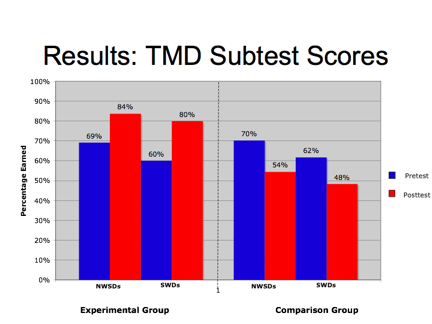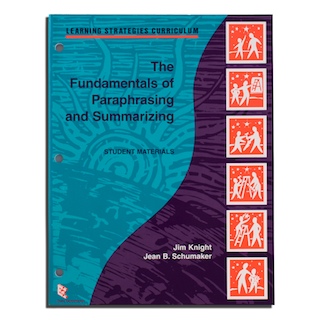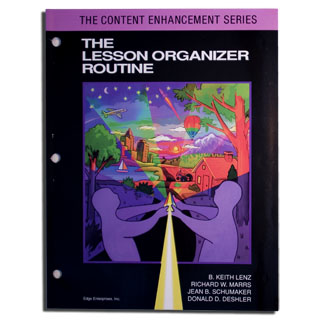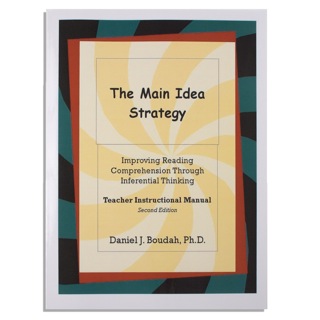Description
Research on the Fundamentals of Paraphrasing and Summarizing Program
Overview
This study investigated the effects of teaching the fundamental skills associated with paraphrasing and summarizing in relation to students’ ability to identify and paraphrase main ideas and details. Two experimental general education classes of tenth graders (n = 43), in which some students with disabilities had been included, worked through the lessons in the Fundamentals of Paraphrasing and Summarizing Program. A comparison class (n = 23) of tenth graders received typical English instruction. There were some students with disabilities included in this comparison class, as well. The classes were randomly selected into the conditions. All students took a test where they had to write paraphrases of the topic, main idea, and details of each paragraph in a different passage before and after the instruction. The design was a pretest-posttest comparison-group design.
Results
Figure 1 shows the mean percentage scores earned by the students on a test where they had to paraphrase as they wrote the topic, main idea, and details for each paragraph in a passage. Students who had disabilities (SWDs) and students who did not have disabilities (NSWDs) in the experimental classes earned higher mean scores on the posttest than the pretest. The opposite was true for the students in the comparison class; their posttest mean scores were lower than their pretest scores.

An ANCOVA revealed significant differences between the posttest scores of the experimental and comparison students without disabilities (NSWDs) in favor of the experimental group [F (1,53) = 54.404, p < .0005, η2 = .507]. This difference represents a very large effect size. Two-tailed t tests revealed that there were no differences between the pretests of the students with disabilities in the groups, but there were significant differences between the groups’ posttests [t (4.115) = 3.307, p < .028, d = 3.31], in favor of the experimental students with disabilities. Again, this difference represents a very large effect size.
Conclusions
Students in general education English classes could learn fundamental skills associated with paraphrasing and summarizing, two reading comprehension strategies. Both students with and without disabilities learned how to identify and paraphrase topics, main ideas, and details in paragraphs in reading passages above the 80% level, which is generally considered to be a mastery level for learning strategies. Moreover, their scores on the posttest were significantly higher than the posttest scores of their peers in a comparison class.
Reference
Graner, P. (2007). The effects of strategic summarization instruction on the performance of students with and without disabilities in secondary inclusive classes.Unpublished doctoral dissertation. Lawrence: University of Kansas.
About the Author

Jim Knight, Ph.D.
Affliations
Research Associate and Certified SIM Professional Development Specialist
University of Kansas Center for Research on Learning
My Background and Interests
My life’s work is studying what is required to help students become better learners. This interest started back in 1985 when I was a community college teacher sharing the Sentence Writing Strategy with my students. This research-based strategy really made a difference for me and my students, and I wanted to learn more about the best ways to share information about best practices with other teachers. Since then, my work has especially focused on professional learning and, in particular, instructional coaching. I spend the bulk of my time studying and training instructional coaches.
In my personal life, I am happily married to Jenny Ryschon-Knight, the proud father of five children, Geoff, Cameron, David, Emily, Ben, and the step-dad of Isaiah Nichols. I love music, running, hockey, and, of course, Jayhawk basketball.
The Story Behind the Fundamentals of Paraphrasing and Summarizing Program
In 1999, as I was directing a comprehensive school reform project called “Pathways to Success,” my colleagues and I shared many of the learning strategies with general education teachers in the Topeka, Kansas School District. We found that teachers loved to teach the writing strategies because every skill that each student had to learn was taught explicitly in sequence with other skills. The writing strategy instruction was very step-by-step, and that was really helpful for students and teachers. In particular, the teachers told us that the Fundamentals of the Sentence Writing Strategy program was very helpful because it provided students with the essential background skills they needed as prerequisites for the more complex writing strategies and helped them become successful writers.
I decided to create a Fundamentals of Paraphrasing and Summarizing program, modeled on the Fundamentals of Sentence Writing Strategy program. I adapted the instructional format to teach some foundational reading strategies and skills. Over a semester, I created the learning sheets and tried them out in collaboration with teachers, modifying the materials based on their feedback. Then, we conducted the first of two studies using the materials with seventh-grade students at French Middle School.
Early in the process, I convinced Jean Schumaker to collaborate with me on the project. She wrote the instructor’s manual and provided suggestions about the format of the materials. Jean also added and created the final lesson. I did a second study, again with seventh-grade students at French Middle School, and both studies demonstrated significant gains for students who received instruction in the strategy compared to students who had not received the instruction.
My Thoughts About the Fundamentals of Paraphrasing and Summarizing Program
The Fundamentals of Paraphrasing and Summarizing program is designed to be used in both large-group and small-group instructional situations. I first used the program in reading classes with more than twenty students, and it worked very well, thanks in large part to the learn- by-watching, learn-by-sharing, learn-by-practicing approach, which is modeled after Anita Archer’s “I do it, We do it, You do it” approach.
My other goal, when creating the learning sheets, was to provide teachers with all of the reading passages so they would have everything they need to teach the skills, and I really wanted to create readings that would be interesting for students. I also hoped that the readings would be prompts for lively discussions in the classroom.
Teacher and Student Feedback on this Program
When I did my initial study of the Fundamentals of Paraphrasing and Summarizing program, I heard many encouraging comments. Perhaps most importantly, students who were struggling learners were happy to plot their progress and show me just how well they were doing. Their teacher reported that she saw students who had been struggling all year succeeding with the materials.
Since then, I’ve received dozens of emails from teachers who are grateful for the step-by-step structure of the lessons and for the inclusion of all the reading passages they need to teach the skills. Teachers have also written to say that they really didn’t know how to teach these skills before they learned about this program, but now they feel they clearly understand how to teach students the basic skills associated with paraphrasing and summarizing.
My Contact Information
Jim Knight, Ph.D.
Research Associate
University of Kansas Center for Research on Learning
1122 West Campus Road
Lawrence, KS 66045
Email: jknight@ku.edu Work Phone: 785-550-8708








